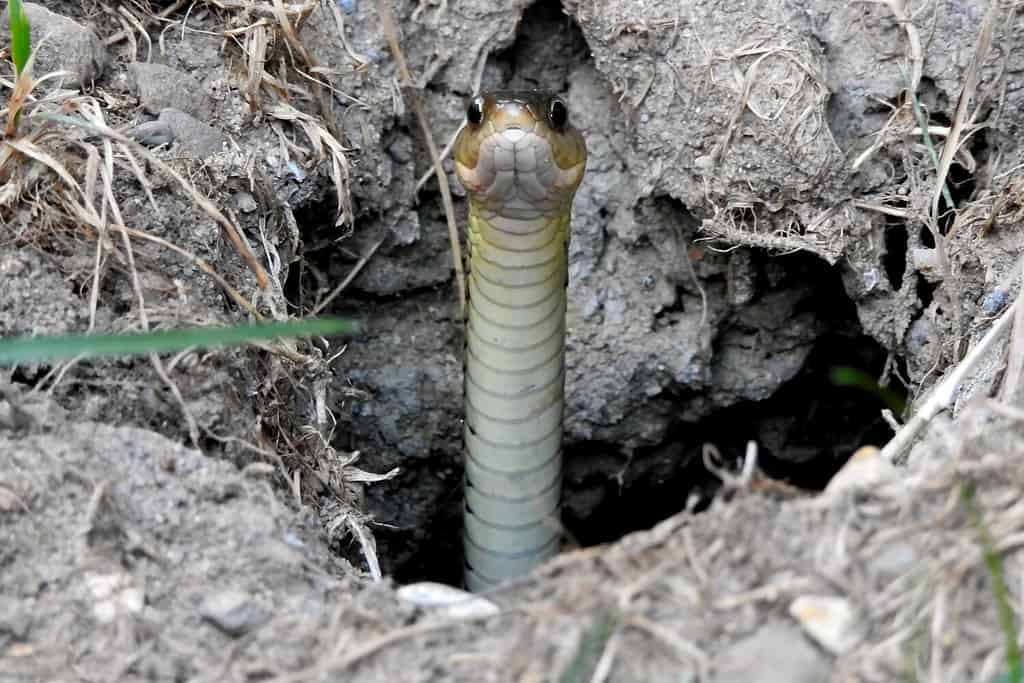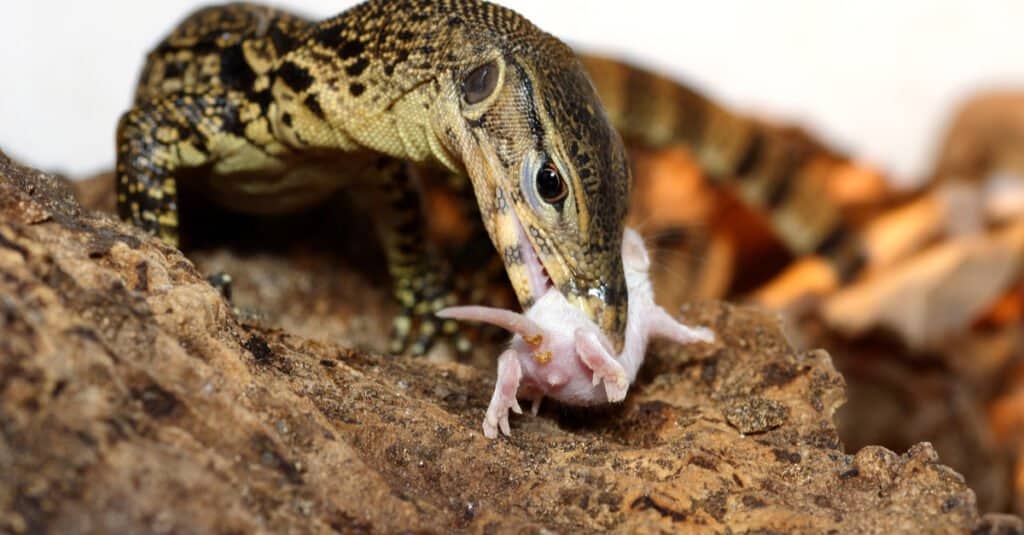Monitor lizards and snakes are two types of reptiles that are popular both to keep as pets and to learn about or study. Monitor lizards are lizards in the genus Varanus which are usually on the large side for lizards, with strong legs and long claws. Snakes are reptiles in the suborder Serpentes which have elongated bodies and no legs. The two animals may seem completely different, but there are several important similarities between them.
Biology

Snakes may have evolved to lose their legs so they can better fit in tight spaces.
©mhagen Photography/Shutterstock.com
The most obvious similarity between monitor lizards and snakes is that the two are biologically related. Not only are both reptiles, but both belong to the order Squamata, which includes all lizards as well as snakes. Lizards and snakes are classified in the same order because physiological and genetic evidence indicates that snakes evolved from lizards. The ancient ancestors of snakes had legs, like modern day lizards do, but over time they lost their legs through evolution and developed the ability to move around by slithering instead. Snakes still have some physical traits in common with lizards, such as their scaly skin, which both reptiles shed as they grow.
Monitor lizards in particular may be the closest living relatives of snakes. Some research suggests that snakes specifically evolved from platynotans, a group of lizards that includes monitor lizards as well as a variety of extinct species. While not all the research supports this idea, the research that does support it helps explain the other things the two reptiles have in common.
Diet

Most monitor lizards are carnivores and eat a variety of small animals.
©Valt Ahyppo/Shutterstock.com
Another obvious similarity between monitor lizards and snakes is their diet. Both snakes and monitor lizards are primarily carnivores, meaning they exclusively eat other animals.
Most monitor lizards are carnivores, but a few are omnivores that eat plants and fruit in addition to animals. Many wild monitor lizards eat a lot of carrion, animals that are already dead. They also hunt small mammals, birds, other reptiles, amphibians, and crustaceans, as well as the eggs of birds and reptiles. Some of the largest species, such as Komodo dragons, will hunt larger animals such as deer, wild boars, or water buffaloes. Smaller species primarily eat small invertebrates such as insects, millipedes, and scorpions. Pet monitor lizards can eat certain foods sold for humans, such as chicken, turkey, fish, shrimp, eggs, and organ meats, as well as whole prey such as mice and rats. Smaller pet monitors will primarily eat insects such as crickets, mealworms, waxworms, or roaches. Commercial food and supplements are also available for pet monitor lizards.
All snakes are carnivores. They swallow their prey whole, and unlike monitor lizards, they rarely eat carrion or human food. A snake’s preferred prey varies based on the species of snake and its size, but snakes may eat rodents, other small mammals, birds, other reptiles (including smaller snakes), amphibians, fish, insects, earthworms, slugs, or eggs. Some of the largest snakes, like anacondas, will occasionally eat larger animals like deer, monkeys, or capybaras. Many snakes are opportunistic carnivores, meaning they will eat any animal they are able to catch. Pet snakes need to be fed whole prey animals. For most species of snakes kept as pets, this prey will be mice or rats, but some large species may need larger prey such as rabbits or chickens.
Diversity

The reticulated python is the longest type of snake, growing over 20 feet long.
©PhotoRoman/Shutterstock.com
Another similarity between snakes and monitor lizards is that neither is a single species of animal. Both are large and diverse categories containing many different species. Even the selection of species kept as pets includes a lot of variety.
There are about 80 different species of monitor lizards. They can be found in parts of Africa, Asia, Australia, and some islands in the Pacific and Indian oceans. There are about 4000 species of snakes, and they are found all over the world, on every continent except Antarctica.
Diversity in Size
The different species of monitors and snakes vary in many ways, but one particularly notable variation that occurs in both is size. The largest monitor lizard, and the largest lizard overall, is the Komodo dragon. The largest known Komodo dragon was 10.3 feet long and weighed 366 pounds. The smallest monitor lizard is the Dampier Peninsula monitor, which weighs less than an ounce and is about nine inches long. Which snake is the largest depends on how you measure them. The longest snake is the reticulated python, which can be more than 20 feet long. The heaviest snake is the green anaconda, which is shorter but bulkier than the reticulated python and weighs up to 550 pounds. The smallest snake is the Barbados threadsnake, which is only 4.1 inches long. These are both enormous size ranges, and both monitor lizards and snakes come in all sizes between the two extremes, which goes to show their incredible diversity.
Diversity in Habitat
Another way the different types of monitor lizards and snakes vary is in where they live. Monitor lizards primarily live in warm climates, but they can be found in both wet rainforests and dry deserts. Some kinds also live in and around water, while others live in trees. Snakes live in a wide variety of habitats including deserts, grasslands, forests, and swamps. There are also aquatic snakes, which can be found in both saltwater and freshwater. Snakes can be found in all climates except for the cold climates of polar regions. In temperate climates, snakes will hibernate during the winter.
Danger

Monitor lizards have sharp teeth and bacteria in their mouths, making their bites dangerous.
©kiwisoul/ via Getty Images
A final important similarity between snakes and monitor lizards is that both are potentially dangerous to humans. However, it is possible to stay safe around them by taking proper precautions. For both of these reptiles, the biggest threat is their bite, which in some species can be venomous.
Venomous snakes are usually the only kinds of snakes that pose a significant danger to humans, and only a small percentage of snakes are venomous. However, it can be difficult to identify venomous snake species, so it is best to keep a safe distance from any wild snake unless you are absolutely certain what kind it is. Most nonvenomous snakes are completely harmless to humans. They rarely bite, and when they do, their bites do very little damage. Some types of snakes are constrictors, meaning they kill their prey by wrapping around them and suffocating them. However, constrictors rarely if ever attempt to constrict humans. The most likely source of danger from a constrictor is a large pet snake accidentally harming a human while climbing on them.
Some types of monitor lizards are also venomous. Even the nonvenomous kinds can have a dangerous bite because of their sharp teeth and the bacteria in their mouths. Fortunately, wild monitor lizards rarely attack humans, and since they are found in fewer places than snakes, you’re less likely to encounter one. There is a higher risk of being injured by a pet monitor lizard, especially if you handle the lizard improperly. Not only can they bite, but they have sharp claws and can scratch. Even a nonaggressive pet monitor lizard may injure a human by accident while playing with or climbing on them. That is one reason why it is important to know a lot about reptiles before adopting one as a pet, especially a potentially dangerous species like a monitor lizard or large snake.
The photo featured at the top of this post is ©
Thank you for reading! Have some feedback for us? Contact the AZ Animals editorial team.






